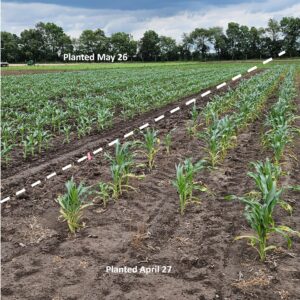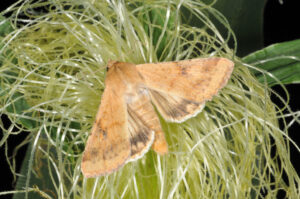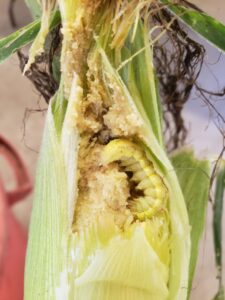This has been a tough, dry year for all of us. I know my early planting of sweet corn at the research farm, seeded on April 27, has been slow and required irrigation (Figure 1).

Figure 1. Progress of two different sweet corn plantings at the Meigs Horticulture Farm in Lafayette, IN (Photo by Laura Ingwell).
However, those of you that may be at the tassel or silking stage should keep a close eye on the state-wide trapping and monitoring program for corn earworm adults (Figure 2), found here. Traps have been placed at 11 locations throughout the state, and catches last week are already exceeding thresholds at some locations in the state.
This moth, like many, is active at night, flying around looking for a mate or suitable host plants. Eggs are laid individually on the developing silk of corn. They hatch within 2-5 days, and the larvae follow the silk channel down into the developing ear to feed (Figure 3). Once inside the ear, they are protected from most foliar sprays. Therefore, monitoring and spray coverage is key. Please refer to Extension bulletin E-31 to learn more about corn earworm identification and management.
In our landscape, we have a lot of resources for these moths to choose from. Therefore, when it comes to protecting your valuable sweetcorn ears, we need to consider the population pressures (how many moths are on the landscape) AND the amount of resources (how much yummy corn is available). This is why we have variable recommendations for when to spray. Early and late plantings of sweetcorn have a lower threshold of moth presence because they are often the only resource on the landscape that is in the optimal stage attractive to the females, the silk stage. At this time of year, if you are catching one moth per day in a trap near your farm and there is no field corn at the silk stage, we recommend that you treat your sweetcorn. However, when the field (dent) corn begins to silk, the number of moths per night increases to 10. This is because the population pressure is spread across a larger resource base.
How often should you spray? This will depend on the product that you choose and the growth rate of the crop. In our hot dry weather, if you are not irrigating your crop, growth is likely slow. If you irrigate or are getting ample rain, then silk production can happen quickly. To protect the developing ear, you need a lethal dose of the chemical present on the silk when the eggs of the caterpillar hatch. It is in those first few bites that you have an opportunity to control them. Once they are inside the ear, they are protected.
Some of the products that we have labeled for sweetcorn have translaminar activity, meaning that even though they are applied as a foliar spray, they move through the plant and into plant parts that were not directly covered. This includes diamides. Using one of these products will increase your spray window, meaning you can increase your spray interval to 5-7 days or more. If you use a product like one of the foliar spray formulations of Bt or a pyrethroid, only the material that was sprayed is protected. If your crop is growing quickly, you may need to re-apply every 3-5 days to get adequate protection. For conventional growers, we recommend using Coragen® in rotation with Radiant®. Coragen® is a diamide and can offer protection for a longer window between sprays (7 days or more). It does come at a higher price compared to the standard pyrethroids that are used. However, you make fewer applications which means less time in the sprayer and less fuel in the tractor! For certified organic growers, Bt foliar sprays offer good control but reapplication may be frequent. See the Midwest Vegetable Production Guide for a complete list of spray recommendations. Be sure to search the database for the crop: sweet corn and the pest: caterpillars.

